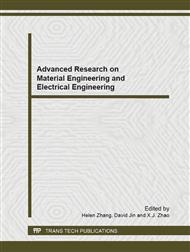[1]
Wen-Chian Lian, Hung-Chi Hsiao, Cheng-Chun Chou: Survival of bifidobacteria after spray-drying. International Journal of Food Microbiology, Vol.74 (2002), p.79
DOI: 10.1016/s0168-1605(01)00733-4
Google Scholar
[2]
Servin, A. L: Antagonistic activities of lactobacilli and bifidobacteria against microbial pathogens. FEMS Microbiol. Vol. 28(2004), p.405.
DOI: 10.1016/j.femsre.2004.01.003
Google Scholar
[3]
Anil Kumar Anal and Harjinder Singh: Recent advances in microencapsulation of probiotics for industrial applications and targeted delivery. Trends in Food Science & Technology Vol. 18 (2007), p.240.
DOI: 10.1016/j.tifs.2007.01.004
Google Scholar
[4]
Baati, L., Fabre-Ga, C., Auriol, D., & Blanc, P. J.: Study of the cryotolerance of Lactobacillus acidophilus: Effect of culture and freezing conditions on the viability and cellular protein levels. International Journal of Food Microbiology, Vol.59 (2000), p.241.
DOI: 10.1016/s0168-1605(00)00361-5
Google Scholar
[5]
Carvalho AS, Silva J, Ho P, Teixeira P, Malcata FX, Gibbs P: Relevant factors for the preparation of freeze-dried lactic acid bacteria. Int Dairy J. Vol. 14(2004), p.35
DOI: 10.1016/j.idairyj.2004.02.001
Google Scholar
[6]
Antonis Ampatzoglou, Benjamin Schurr, Gurjot Deepika, Sasitorn Baipong, Dimitris Charalampopoulos. Influence of fermentation on the acid tolerance and freeze drying survival of Lactobacillus rhamnosus GG. Biochemical Engineering Journal, Volume 52, Issue 1, 2010, p.65
DOI: 10.1016/j.bej.2010.07.005
Google Scholar
[7]
Clarissa Schwab, Rudi Vogel, Michael G. Gänzle. Influence of oligosaccharides on the viability and membrane properties of Lactobacillus reuteri TMW1.106 during freeze-drying. Cryobiology, Volume 55, Issue 2, 2007, p.108
DOI: 10.1016/j.cryobiol.2007.06.004
Google Scholar
[8]
María Claudia Otero, María Carolina Espeche, María Elena Nader-Macías. Optimization of the freeze-drying media and survival throughout storage of freeze-dried Lactobacillus gasseri and Lactobacillus delbrueckii subsp. delbrueckii for veterinarian probiotic applications.Process Biochemistry, Volume 42, Issue 10, 2007, p.1406.
DOI: 10.1016/j.procbio.2007.07.008
Google Scholar
[9]
Guowei Shu, Man Hu, Tao Qin, He Chen, Ma Qi: Effect of fructo-oligosaccharide, isomalto- oligosaccharide, inulin and xylo-oligosaccharide on survival of B. bifidum during freeze-drying. Advanced Materials Research,Vol. 382(2012),pp.454-457
DOI: 10.4028/www.scientific.net/amr.382.454
Google Scholar


